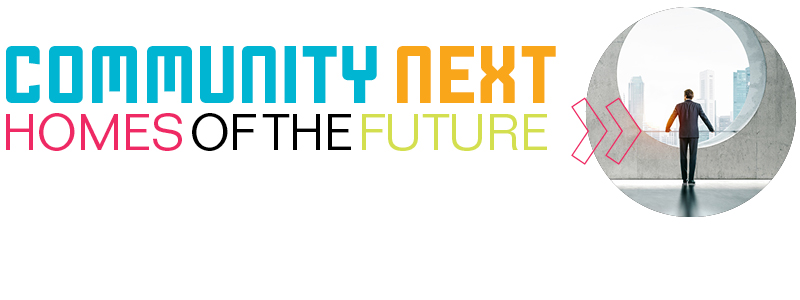
Envisioning the future of community association living, governance, and management.
Community association volunteers, managers, and business partners work hard to maintain common areas and facilities, offer amenities and events, uphold rules and covenants, collect assessments, and communicate with residents to remain open and transparent. These efforts occur on a daily basis and directly relate to preserving, protecting, and enhancing common-interest communities. Yet community association leaders have to look beyond this day-to-day operational and governance work. There are many challenges and opportunities waiting. That's why CAI launched the Community Next: 2020 and Beyond initiative in 2015. The report that culminated from the initiative represents the best thinking of several dozen CAI leaders and nonmember community association stakeholders.
It tackled topics like:
- How community associations will evolve
- How best practices in governance and management are likely to change over time
- What the inevitable changes will mean for the association management profession
- How decisions by legislatures, regulators, and the courts will affect the way associations function
- How external trends and opinion leaders will influence the future of associations
 The report helped to define the future of the community association housing model. It also provided ideas and action items on how to minimize uncertainty and elevate the collective ability to manage the future. Today, we’re already seeing some of the challenges and opportunities the report addressed come to fruition. Research shows an increasing number of community associations worldwide and the growing influence of homeowners in communities. At the same time, technology and demographics (baby boomers aging in
The report helped to define the future of the community association housing model. It also provided ideas and action items on how to minimize uncertainty and elevate the collective ability to manage the future. Today, we’re already seeing some of the challenges and opportunities the report addressed come to fruition. Research shows an increasing number of community associations worldwide and the growing influence of homeowners in communities. At the same time, technology and demographics (baby boomers aging in  place and millennials becoming homeowners) are changing how homes are built and how communities are developed. That’s why we’re turning back to some of the same experts mentioned above to bring youCommunity Next: Homes of the Future. This next step in CAI’sCommunity Next series offers ideas on integrated technology, government partnerships, banking and internet security, global access to information, the future of reserve studies, and electric vehicles. For almost 45 years, CAI has educated, informed, and advocated for people who live and work in common interest communities. Thanks to these ongoing efforts, we have a strong and valuable understanding of community associations today. And now, thanks to Community Next, community association volunteers, managers, and business partners can focus on their daily roles and prepare for the future.
place and millennials becoming homeowners) are changing how homes are built and how communities are developed. That’s why we’re turning back to some of the same experts mentioned above to bring youCommunity Next: Homes of the Future. This next step in CAI’sCommunity Next series offers ideas on integrated technology, government partnerships, banking and internet security, global access to information, the future of reserve studies, and electric vehicles. For almost 45 years, CAI has educated, informed, and advocated for people who live and work in common interest communities. Thanks to these ongoing efforts, we have a strong and valuable understanding of community associations today. And now, thanks to Community Next, community association volunteers, managers, and business partners can focus on their daily roles and prepare for the future.
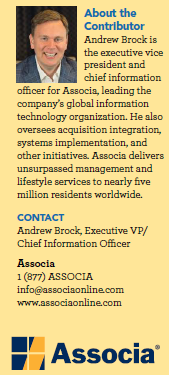 Our increasingly digital world is changing everything—from our purchasing patterns to how we interact with our friends and family. It’s also affecting how we manage our homes and communities. It’s promising to make us more effective board members and more engaged residents. But it’s important to remember one simple truth: Some things never change. One of an association’s most important duties is to enhance the community living experience for residents. This is best achieved by focusing on:
Our increasingly digital world is changing everything—from our purchasing patterns to how we interact with our friends and family. It’s also affecting how we manage our homes and communities. It’s promising to make us more effective board members and more engaged residents. But it’s important to remember one simple truth: Some things never change. One of an association’s most important duties is to enhance the community living experience for residents. This is best achieved by focusing on:
Sustainability. Keeping the community operating at its peak by providing improvements and programs that both maintain and increase home values.
Security. Safeguarding funds, data, and community physical security, while also providing access and convenience.Engagement. Finding ways to give back and foster a strong sense of community. The right technology solutions can help boards fulfill their commitments in each of these areas.
Historically, however, the community association industry has been slow to adopt new technology. And in all fairness, technological innovation in this industry has trailed the market. That dynamic is now changing, and boards—who may not have experience choosing technology solutions for managing communities—are exploring ways to capitalize on these new offerings. And there are plenty.
With the current push to integrate technology into every area of our lives, one doesn’t have to look far to find a new technology solution for any aspect of managing a community. Boards, eager to simplify their roles and satisfy homeowner demands, and entrepreneurs, looking to disrupt another industry, are causing an interesting shift. On one side, entrepreneurs with little industry knowledge and a lot of desire to supply solutions to an untapped market are busily building and launching new products.

To get to the market fast, these products tend to be “feature lite,” meaning that they’re focused on a single solution. On the other side, you have board members, hastily signing up for these promising products as quickly as they’re available. How will this play out? Boards will soon find themselves toggling between multiple solutions to perform their duties. They will become so entrenched in managing all of these new, non-integrated technology platforms that they won’t experience the initial selling point: creating more efficiencies for the community. Communities will begin to demand single-platform, fully integrated solutions that improve the community living experience. It’s easy to see why these siloed technology offerings are inefficient and ineffective for board members and the communities they lead. So what does the future technology environment look like for associations? The simple answer is that communities will begin to demand single-platform, fully integrated solutions that improve the community living experience. But I think it goes a step further. The lasting solutions of the future will not only meet those needs, but they will also seamlessly fit into our lifestyles. Boards and residents will be able to integrate technology into their lives wherever they are, with features that enhance the operational needs of the association while also enriching the social aspects of community living. If board members approach technology with a focus on their core obligations and adopt a strategic approach to selecting integrated solutions, they’ll be equipped to lead their communities into the bright future that this digital revolution offers. This is the first post in a series that will continue on Associa’s Better Living Blog: hub.associaonline.com.
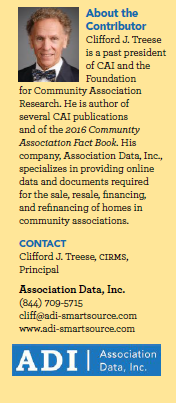 equivalent of homeownership today. Once land was distributed, issues arose from uncontrolled urbanization and fragmented housing development. Early 20th-century Americans emphasized infrastructure development for water, sewers, highways, and other public utilities and services. Gradually, these practices came under local zoning and development requirements. Land use practices in the early 21st century, however, illustrate a shift away from controlling land use through zoning toward relying on associations to govern and fund new housing infrastructure. Indeed, developers are now required to place long-term maintenance and infrastructure responsibility on new associations. What used to be funded by real estate tax dollars must now be funded directly by homeowners. Community associations are efficient and economical housing management organizations, but they cannot meet future challenges alone. Consider, for example, today’s looming problems and how partnerships with all levels of government might solve them in the future.
equivalent of homeownership today. Once land was distributed, issues arose from uncontrolled urbanization and fragmented housing development. Early 20th-century Americans emphasized infrastructure development for water, sewers, highways, and other public utilities and services. Gradually, these practices came under local zoning and development requirements. Land use practices in the early 21st century, however, illustrate a shift away from controlling land use through zoning toward relying on associations to govern and fund new housing infrastructure. Indeed, developers are now required to place long-term maintenance and infrastructure responsibility on new associations. What used to be funded by real estate tax dollars must now be funded directly by homeowners. Community associations are efficient and economical housing management organizations, but they cannot meet future challenges alone. Consider, for example, today’s looming problems and how partnerships with all levels of government might solve them in the future.
Problem: Infrastructure is too complex, and too expensive, to be funded solely by associations and their homeowners. Solution: Local government could either take over the burden that is already paid with tax dollars or adopt New Jersey’s approach, which provides for municipal services equalization. In this model, local governments in the state reimburse associations the amount they would have paid for certain municipal services. This approach works, as far as it goes. It doesn’t cover streets and roads, for example.
Problem: Associations are increasingly supporting residents who are aging in place largely because few other private or public options exist. Solution: Local government—and even the federal government—might provide income tax credits to younger homeowners if the association is home to, say, 10, 15, or 20 percent of residents over 55. State legislatures also might allow associations to give some assessment relief to 55+ owners—if owners approved.
Problem: Although land suitable for development is available, resources like water, oil, and lumber may not be.Solution: Because community associations, collectively, conserve more—and control spending better— than a non-association subdivision, local, state, and federal governments What used to be funded by real estate tax dollars must now be funded directly by homeowners. could give matching dollars to associations that spend certain amounts to conserve water or use recycled materials, for example. 
Problem: Associations may not be able to keep up with the increased maintenance costs that will result from climate change. Solution: When climate change brings floods, windstorms, or other natural disasters more frequently and causes damage more often, state and federal governments should provide disaster relief to associations that demonstrate a history of sound financial practices. In 2017, the only commercial industry that takes climate change seriously is insurance— because insurers pay the claims. State legislatures should embrace the Building Code Effectiveness Grading program, which allows insurers to charge higher premiums for associations that don’t meet certain standards that would minimize property claims. Future land use practices will be shaped by concerns much broader than the historical circumstances that launched America’s housing industry. Associations can no longer evolve without cooperation and partnerships with all levels of government. 
The electric vehicle market has grown exponentially over the past few years. States like California and Hawaii, which have adopted laws that allow homeowners to install vehicle charging stations, have been leading regulatory efforts to encourage electric vehicle adoption. Community association leaders should expect residents to bring these vehicles home in increasing numbers in coming years, and they should be prepared.
Boards and managers should be asking:
Who pays for the electricity to charge electric vehicles?
Who pays for infrastructure upgrades?
Can our buildings handle the electrical loads?
 » DISTRIBUTION BASICS
» DISTRIBUTION BASICS
 association’s electrical distribution system routes electricity throughout the building to critical systems that allow residents to live comfortably— like elevators, hot water heaters, and electric vehicle charging stations. With preventive maintenance, electrical distribution systems have an average life expectancy of about 30 years. Without preventive maintenance, system integrity can slowly break down, creating a chain reaction of failures and weakening other components.
association’s electrical distribution system routes electricity throughout the building to critical systems that allow residents to live comfortably— like elevators, hot water heaters, and electric vehicle charging stations. With preventive maintenance, electrical distribution systems have an average life expectancy of about 30 years. Without preventive maintenance, system integrity can slowly break down, creating a chain reaction of failures and weakening other components.
Associations should keep the following factors in mind:
Life safety. Your facility is more likely to burn down because of an electrical hazard than any other cause.Business interruptions. When the lights go out, it isn’t just inconvenient for everyone. It may also be hazardous and costly. Businesses in the building could lose revenue and request rent relief or other compensation.Power quality. Most buildings can handle only six level two electric vehicle charging stations. More than six can drain power throughout the building.Utility costs. Without preventive maintenance, an electrical distribution system can lose as much as 4 percent of its electricity. Metal in the system expands and contracts during normal operation. Over time, this loosens connections; they must be tightened regularly as part of a preventive maintenance program. Asset management. Typically, electrical equipment replacement costs range from 10 to 15 percent of a build- Community association leaders should expect residents to bring these vehicles home in increasing numbers in coming years, and they should be prepared. ing’s conduction cost, and an electrical distribution system can easily cost more than $1 million.Insurance certification. A comprehensive maintenance program reduces the risk of an electrical fire for you—and reduces claims for your insurer. In fact, many insurance companies today require that associations perform preventive maintenance. Documenting maintenance activities may help the association qualify for additional discounts. All manufacturers require periodic maintenance on electrical distribution equipment. And even if they didn’t, it’s a good idea considering the parking garage will soon be filled with electric vehicles and charging stations making ever-increasing demands on that system. Remember, the local utility companyis only responsible for providing power to the building. From that point, the responsibility lies entirely with the association. Fulfill that responsibility by ensuring the electrical distribution system is operated properly and maintained regularly.
Asset management. Typically, electrical equipment replacement costs range from 10 to 15 percent of a build- Community association leaders should expect residents to bring these vehicles home in increasing numbers in coming years, and they should be prepared. ing’s conduction cost, and an electrical distribution system can easily cost more than $1 million.Insurance certification. A comprehensive maintenance program reduces the risk of an electrical fire for you—and reduces claims for your insurer. In fact, many insurance companies today require that associations perform preventive maintenance. Documenting maintenance activities may help the association qualify for additional discounts. All manufacturers require periodic maintenance on electrical distribution equipment. And even if they didn’t, it’s a good idea considering the parking garage will soon be filled with electric vehicles and charging stations making ever-increasing demands on that system. Remember, the local utility companyis only responsible for providing power to the building. From that point, the responsibility lies entirely with the association. Fulfill that responsibility by ensuring the electrical distribution system is operated properly and maintained regularly. When it comes to cybersecurity and the inherent risks associated with internet and mobile banking, the future is already here. The Association for Financial Professionals conducted its 2017 annual Payments Fraud and Control Survey and found payment fraud and data breaches are increasing. Neither huge corporate
When it comes to cybersecurity and the inherent risks associated with internet and mobile banking, the future is already here. The Association for Financial Professionals conducted its 2017 annual Payments Fraud and Control Survey and found payment fraud and data breaches are increasing. Neither huge corporate giants like Target and American Express nor small mom-and-pop stores are completely immune.
giants like Target and American Express nor small mom-and-pop stores are completely immune.
Cyber threats also affect community associations, which hold sensitive information about their homeowners. To avoid becoming victims of internet fraud, all communities should follow the recommended best practices and use all available defenses. A Cyber Liability insurance policy can provide coverage for these perils, but education and proactive measures are the best defenses.
Financial institutions are taking the necessary steps to secure their customers’ assets, information, and identity. Many banks today have partnered with malware service providers to prevent phishing; to provide secure access to their websites; and to detect, prevent, and remediate mobile threats.
Additionally, many banks offer online banking tools that provide additional security and rigorous safeguards, including:
❚ Strong password requirements
❚ Protection from credential harvesting— gathering authentic login credentials
❚ Authentication features to verify valid usersOther online banking safeguards include:
❚ Requiring dual approvals to add, change, or delete users
❚ Requiring dual approvals to change wire and electronic payment instructions
❚ Granting unique access and functions for each user
❚ Providing alerts that report account activity immediately
❚ Setting limits on financial activity for each account user Positive Pay is another online banking safeguard. When a check is deposited or cashed, the automated fraud detection tool matches the account number, check number, and amount against a list of checks previously authorized and issued. The check must match the details provided by the issuer, or the check will not be paid.
» CYBERSECURITY TIPS
Individuals can take steps to protect their accounts too. Follow these do’s and don’ts:
Do
❚ Review bank accounts daily. Vigilance is the first line of defense.
❚ Maintain separate workstations when working with sensitive accounts and critical systems.
❚ Change passwords often and make them complex.
❚ Install personal firewalls and update rules regularly.
❚ Log out of the banking website after you’re done using it.
Don’t
❚ Open emails from unknown sources.
❚ Install software from unknown sources or websites.
❚ Record passwords.
❚ Click on unknown internet links.
❚ Use a generic user ID. By following these steps diligently, and partnering with a bank that safeguards your data and privacy, you can do your best to combat the rising threat of cyber fraud.
______________________________________________________________________________________________
The information mentioned in this article is for informational purposes only, is intended to provide general guidance, and does not constitute legal or professional advice. You should seek the advice of a professional advisor and/or legal counsel to address your specific needs regarding the issues related to your situation. Banco Popular North America does not make any representations or warranties as to the content contained herein and disclaims any and all liability resulting from any use of or reliance on such content. One need not look any farther than millennials and their work ethic to identify future trends. In 2016, millennials became the largest generation in U.S. history. As leaders, they are aligning their knowledge and sense of unity with community association best practices.
One need not look any farther than millennials and their work ethic to identify future trends. In 2016, millennials became the largest generation in U.S. history. As leaders, they are aligning their knowledge and sense of unity with community association best practices.
As innovators, some of their needs include:
❚ An insatiable thirst for information (millennials are the most educated generation ever)
❚ Immediate access to relevant information (see Google)
❚ Reliable services that add value
❚ A desire for collaboration
» RESERVES REVOLUTION
How do innovative millennials relate to the future of reserve studies? They aren’t content with a static document viewed once a year at budget time or when a capital project is scheduled. Instead, millennial board members and managers now insist on the ability to interact with reserve studies for relevant information on demand in real time. They’re driving the push for cloud-based reserve studies to plan interactively with their communities and their own financial futures. Until now, reserve studies have been fixed in time. As more millenni als join their association boards, they’ll want the ability to interact with their reserve study when common areas change. They’ll want to know:
als join their association boards, they’ll want the ability to interact with their reserve study when common areas change. They’ll want to know:
❚ How will an early major replacement affect our long-term budget (and my budget)?❚ Is there a better option, such as capital repair, to extend a useful life?
❚ Can a bank loan serve our immediate needs while securing our future? The traditional reserve study cannot quickly provide answers to these questions. An interactive, cloudbased reserve study answers these and other questions about the future and allows greater collaboration in a team environment. Cloud-based services like Fore- Site Reserves are available to meet the needs of the millennial generation now and moving forward.
These services allow board members and managers to:
❚ View a dynamic study in real time with online access anywhere, any time
❚ Collaborate with others online with fewer and shorter planning meetings
❚ Make informed decisions with easyto- use, what-if scenarios for replacements, costs, and funding options
❚ Record, share, and document projects in one place
❚ Promote harmony and unity among homeowners by active planning instead of reacting to emergencies As millennials join their association boards, they’ll want the ability to interact with their reserve study when common areas change.
» UNWAVERING EXPERTISE
Interactive platforms are taking reserve studies to the next level. However, the professionals who create reserve studies will still be needed to provide their expert opinions. They will continue to assess the condition, remaining lives, and costs of the common elements—the basis upon which all reserve studies are built. They will determine the appropriate level of reserve contributions needed from the homeowners to provide a community with a solid financial foundation.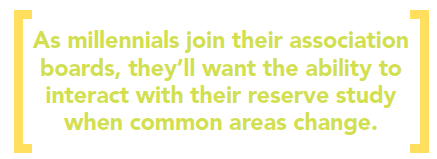 The expertise and best practices found among reserve study providers remain needed and valued, and reserve study providers will continue to partner with the management team and board members to protect all community members’ homes. How association volunteers and managers use and access that expert guidance, however, will evolve—like the community association industry itself—to accommodate their unique and productive approach to conducting business.
The expertise and best practices found among reserve study providers remain needed and valued, and reserve study providers will continue to partner with the management team and board members to protect all community members’ homes. How association volunteers and managers use and access that expert guidance, however, will evolve—like the community association industry itself—to accommodate their unique and productive approach to conducting business.

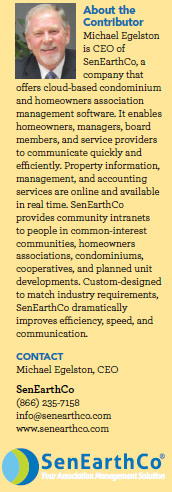 “Alexa, give me the recipe for an Italian margarita.” It was science fiction in 1969; today, it’s commonplace. The way we access information may differ, but access to global knowledge is the essence—shared data. Current trends in home automation span all functional areas from entertainment to security and environmental control.
“Alexa, give me the recipe for an Italian margarita.” It was science fiction in 1969; today, it’s commonplace. The way we access information may differ, but access to global knowledge is the essence—shared data. Current trends in home automation span all functional areas from entertainment to security and environmental control.
“People are turning to smart home automation more and more because of the added security it can bring to a home. Being alerted right away on your smartphone if something is amiss is an incredible benefit of this technology. People are also looking at the potential savings from reducing their energy costs and receiving insurance discounts. And of course, when it comes to the ways home automation can make life more convenient, the possibilities are nearly endless. We expect big things in the next few years from the smart home industry, and we’re excited to see where it takes us.”
—Kate Herrick, ASecureLife.com 2017
Some significant statistics include:
❚ Between 2015 and 2017 the number of smart-home devices increased 64 percent; 80 million devices were shipped worldwide this year. —IHSMarkit.com
❚ The global home automation system market was valued at $39.93 billion in 2016 and is expected to reach $79.57 billion by 2022. —MarketsandMarkets.com
Controlling home devices is one advantage of smart-home technology; accessing information—in the era of big data—is another.
Access to association information will be catching up with access to glocal information very quickly. “Glocal” is a term coined in the 1980s to describe data shared by local and global resources. YFS Magazine (2011) defined it well: “The term glocal refers to the global innovation that is streamlined for local consumption.”
When you combine glocal data with artificial intelligence, you have the home of the future. You can ask questions and get answers from a global database; turn on your home lights; manage your HVAC, or check Today, we access 75 percent of our information on our smartphones, and that percentage will increase in coming years. your home security system, all from a computer or smartphone. Access to global information is astounding. Access to association-specific information needs to be the same. “Can I change paint color? Build a fence? Plant a tree?” The expectation is that access to all information will be easy and fast.
 Over the past 10 years, most management companies have maintained their data electronically. Systems like SenEarthCo have helped computerize and streamline management functions and data. In the coming years, community association residents will demand fast, simple access to community information. They will want to access their association data as quickly and simply as they do the global data through Alexa, Siri, or their smartphones.
Over the past 10 years, most management companies have maintained their data electronically. Systems like SenEarthCo have helped computerize and streamline management functions and data. In the coming years, community association residents will demand fast, simple access to community information. They will want to access their association data as quickly and simply as they do the global data through Alexa, Siri, or their smartphones.
It’s time for the community association industry to disembark from the Starship Enterprise and prepare to share data at warp speed with techsavvy owners of the future.